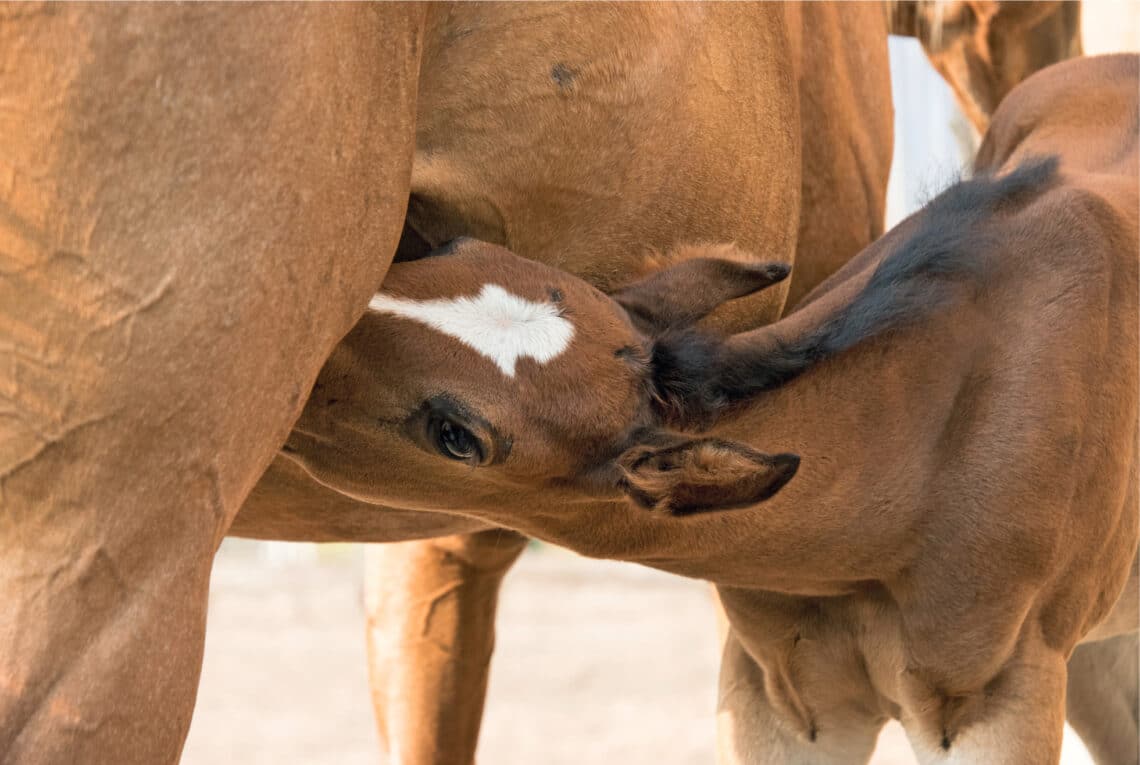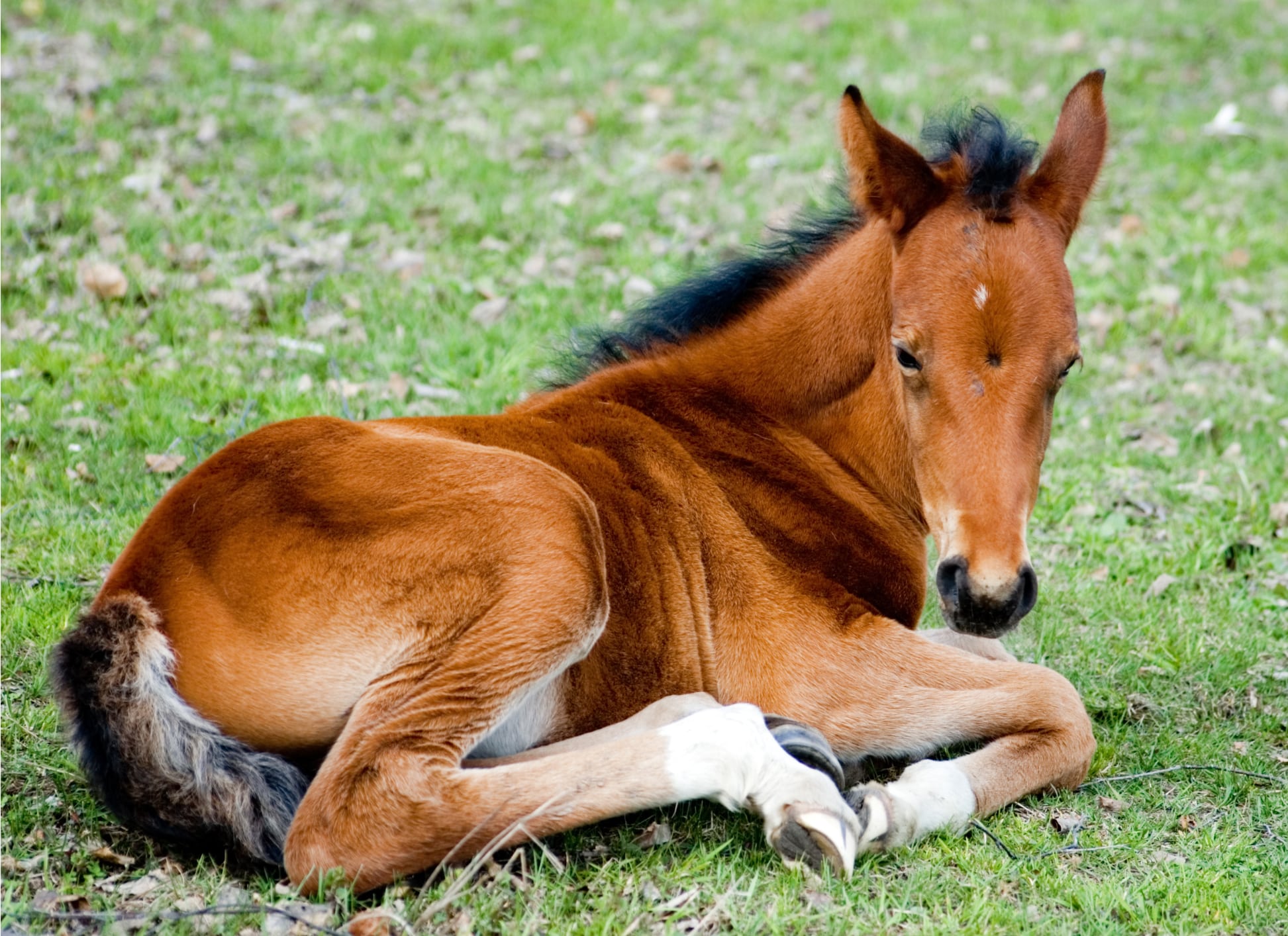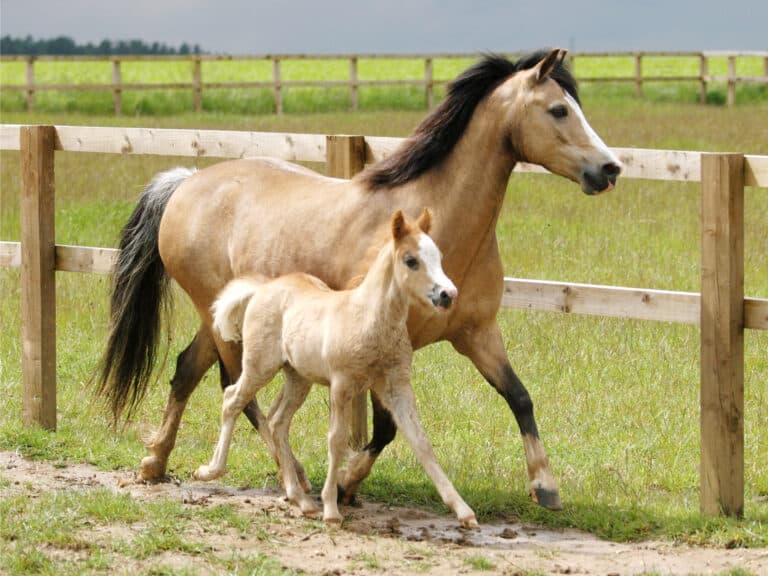
Managing diarrhoea in foals
One of the most common diseases in foals, diarrhoea may require prompt and aggressive treatment, writes Dr JENNIFER STEWART.
Diarrhoea – increased frequency of defecation with increased water content of the manure – is one of the commonest diseases in foals, with most experiencing at least one episode before they are six months old. Usually, diarrhoea is mild and veterinary treatment is not required, less commonly it can be severe and require prompt and aggressive treatment.
There are several times in the life of the foal when the risk of diarrhoea is increased. Understanding when and why they are more likely to become ill at certain ages gives us a greater chance of preventing and avoiding the trauma, costs and consequences of this potentially life-threatening condition.
Broadly, foal diarrhoea can be categorised as related to birth stress, failure of passive transfer, foal heat, nutrition, infections, or worms. But these are not hard and fast rules and any cause/s can occur at any time, in any combination, and some are age-related (Table 1).
The most common non-infectious causes of diarrhoea in foals include foal heat and nutritional or dietary factors, while the most common infectious causes include rotavirus, salmonella and clostridium.
Birth stress: Asphyxia related gut injury (also called neonatal gastroenteropathy) can occur with severe oxygen deprivation at birth. Affected foals often show other signs of brain injury and the gut is affected. Monitoring the mare prior to birth will help identify the at-risk foal. If the mare has a fever, a vaginal discharge, or has previously had a foal with problems, her unborn foal is at greater risk.
Failure of passive transfer (FPT): At birth, the foal has no immunity to disease and the number one protection against diarrhoea and other illnesses in the first three months of life is colostrum. Colostrum is the first secretion of the mare’s udder; it’s the thick, honey-like liquid that accumulates in the udder before the mare produces milk. Colostrum is rich in antibodies and other protective substances, which equip the foal with a ready-made defence system that both prevents bacteria from gaining a foothold in the gut, and destroys organisms that gain entry through the skin or lungs. FPT is when the foal does not receive adequate colostrum, greatly increasing the risk of diarrhoea and other serious conditions.
Three to twenty-four per cent of mares have reduced amounts or poor quality colostrum. Many mares ‘run milk’ prior to birth, or have thick, sticky fluid dried on their legs before foaling. Other mares may have intermittent streaming of liquid from the teats. It is important to assess the colostrum of these mares. Every effort should be made to ensure that foals receive adequate colostrum during the first six to eight hours of life. A blood test (IgG) at 18 hours of age can tell us if the foal has received adequate immunity and if not, your veterinarian can discuss options to correct this.
The foal can only absorb colostrum for 12 to 18 hours after birth. Between 18 and 30 hours of age, the gut cells change and even if colostrum is given it will not be taken up by the foal. Some breeders routinely monitor the foal’s IgG levels at 18 hours of age and many insurance companies require documentation of adequate immunity before they will insure a foal.
Foal heat diarrhoea: Foal heat diarrhoea occurs in around 80% of foals between five and fifteen days old, it lasts three to four days, and is usually self-limiting. It is caused by natural changes in the microflora of the gut and occurs in hand-reared and nursing foals. The diarrhoea is typically mildly loose or slightly watery and foals aren’t sick. It is rarely of any serious consequence, but foals should be monitored to ensure they remain bright, active and continue to suckle. Any foal that scours for more than 48 hours, becomes weak, goes off suck, lies around, becomes sleepy, has signs of colic, or reddening of the gums, must be treated urgently and monitored closely.
Nutrition/diet: Milk overload is often associated with foal diarrhoea and occurs more often in mares fed too heavily during pregnancy and the immediate post-foaling period. The strong, healthy foal tends to over drink and may get gastrointestinal overload which can lead to diarrhoea. Foals are also prone to eating soil, sand, bedding (especially rice or almond hulls) and other foreign material such as hair – all of which can be abrasive in the gut and can cause diarrhoea and/or colic.
Dietary intolerances are more likely in orphan foals on milk replacers – especially if the replacer is prepared either too concentrated or too diluted. Foals should be on mare’s milk exclusively until at least four weeks of age. If allowed access to their dam’s feed, especially if it contains grains, starch or sugars, diarrhoea can result due to the immaturity of the digestive system in terms of digestive juices and microflora.
Infections: At two to four months of age the immunity the foal received from the mare is beginning to wane, and their own immune system must take over. If the foal received insufficient and/or poor quality colostrum, or their own immunity is not fully developed, this age can be a period of risk for many diseases such as diarrhoea, pneumonia (including ‘rattles’), encephalitis and septicaemia.
Worms: Foals aren’t usually severely affected by parasites until weaning or older. However, threadworms/milkworms (Strongyloides westeri) or roundworms (Parascaris equorum) can produce mild diarrhoea in foals between one and two weeks old. Threadworms can be shed in the mare’s milk and roundworms in the manure. To prevent parasite infestation in the foal, ensure that a well-planned parasite program is in place and discuss your worming protocol with your veterinarian, especially in regards to local conditions and worm resistance – a growing and worrying problem.
How do we know if the foal is sick?
It’s really important to know that signs of illness in foals are often vague and similar for many disease conditions. Increased sleepiness, reduced sucking, and slight changes in behaviour may be the only indication that all is not well. Foals normally nurse several times an hour in the early days of their lives – a full udder or milk dripping can indicate the foal may not be nursing normally.
Another sign is dried milk on the foal’s face – an indication that although nuzzling and appearing to suckle, the foal is not swallowing well, a sure sign of impending illness. Foals usually urinate each time they rise and any reduction can indicate dehydration. Other signs of dehydration include lethargy and depression. If your foal is dehydrated, a veterinarian should be contacted immediately.
Close observation of foal behaviour is key to early detection and any deviation from normal behaviour should be considered abnormal. Many diseases that lead to diarrhoea begin with nonspecific signs. Foals with colic, fevers, lethargy, anorexia, or gas distension of the abdomen should be considered at risk for developing diarrhoea. Recognising early clinical signs is important not only for treatment but also for infectious disease control.
Recognition of diarrhoea should be straightforward! Determining the cause is not always so easy, but it is important. The usual signs of infection (high body temperature) are often not present in sick foals. This can make recognition difficult and if the foal is thought to be healthy because their temperature is normal, disease processes can become very advanced before veterinary advice is sought, making treatment more difficult and expensive and reducing the chance of a successful outcome.
Foals with infectious forms of diarrhoea require urgent veterinary attention. They may need antibiotics, intravenous fluids, and possibly other medications to recover and support healing and gastrointestinal function.
How can we help?
Washing the legs and tail with mild soap, drying with a soft towel and applying petroleum jelly, barrier cream or calamine lotion on both hind legs once to three times a day helps prevent skin scalding and hair loss. Your vet may recommend gut protectants such as bismuth subsalicylate, kaolin/pectin products, or DTO (di-tri-octahedral smectite) after the foal is 24 hours old – younger than this can prevent colostrum absorption. Smectite should be used only with veterinary advice.
There are some good reasons to believe manipulation of the gut flora with probiotics has a role in gut health in foals. However, given the dynamic development of the foal microbiota, any efforts to alter its composition should be evidence based. Because of the potential for bacterial or fungal infection, probiotics must be used with caution in foals and only with veterinary advice.

To date, clinical trials in foals show underwhelming evidence of efficacy and a demonstrated potential to aggravate rather than mitigate diarrhoea. Because probiotics have the potential for inadvertent administration of toxin-producing or otherwise pathogenic bacterial strains, as well as strains bearing transferable antimicrobial resistance genes, it is advisable to approach probiotic therapy with caution for the time being, and the use of probiotics in newborn foals is not recommended based on currently available data. Likewise, unless under veterinary guidance, antibiotics are not recommended as a treatment for foal diarrhoea because they can interfere with the establishment of a healthy microbial population.
Reducing the risk of diarrhoea
- Ensure the foal receives good-quality colostrum in the first 18 hours of life.
- Check with your veterinarian regarding rotavirus in your area and vaccinate.
- Move mares to where they will foal at least six to eight weeks before foaling to give them time to build up antibodies to local pathogens.
- If the mare is to foal in a stall, clean the stall with phenolic disinfectants and bed it with good, clean straw.
- Foals with diarrhoea should be isolated from healthy mares and foals.
- Practice good hygiene and wear protective clothing when handling infectious diseases – salmonella and clostridial organisms are also human pathogens. A history of diarrhoea in other foals on the premises is highly suggestive of an infectious and contagious pathogen.
- Disinfectants have different properties and antimicrobial spectrums – bleach (diluted 1:10) has a wide range of germicidal activity but is inactivated by organic matter and is not effective against rotavirus.
- Parasitic (worm) diarrhoeas can be reduced by avoiding overcrowding, segregating foals according to age, disposing of manure and correctly worming mares.
- Newborn foals should not be placed in paddocks used for older foals – paddocks should be rotated backwards, with clean paddocks reserved for newborn foals, after which they can be used by older foals.

Although the signs and nursing management are the same regardless of the cause of the diarrhoea, the treatment, antibiotics and preventative measures differ. Because of this it is vital that the cause of the diarrhoea is accurately diagnosed, and the correct treatment begun as rapidly as possible, rather than adopting a shot-gun approach. In addition, sick foals rarely have only one problem and the sicker they are the more likely they are to develop complications and a series of problems that require attention.
If one localising sign such as diarrhoea is present, it may obscure the fact that other organ systems are also abnormal. Most bacteria, including salmonella, enter through the gut, may or may not cause diarrhoea, and rapidly invade the body to affect the lungs, bones, kidneys, liver, brain and joints. Foals are fragile, and unnecessary – or wrong – treatment can cause tremendous damage.
And, for better or for worse, changes occur quickly in the young foal, so there is little time to spare in decision making. A short delay in beginning therapy can make the difference between success and failure, and veterinary attention should be sought sooner rather than later. Many high-risk foals look relatively good in the first few hours after birth – but this initial 12 to 24 hour period of grace can be followed by a sudden worsening of the condition.
Dr Jennifer Stewart BVSc BSc PhD is an equine veterinarian, CEO of Jenquine and a consultant nutritionist in Equine Clinical Nutrition.
All content provided in this article is for general use and information only and does not constitute advice or a veterinary opinion. It is not intended as specific medical advice or opinion and should not be relied on in place of consultation with your equine veterinarian.



